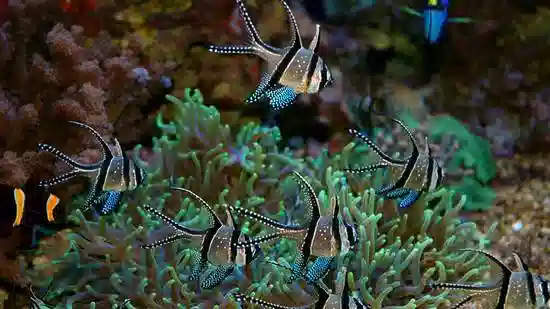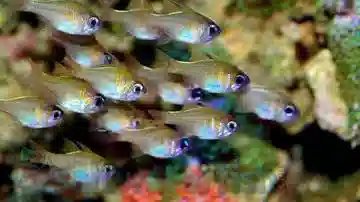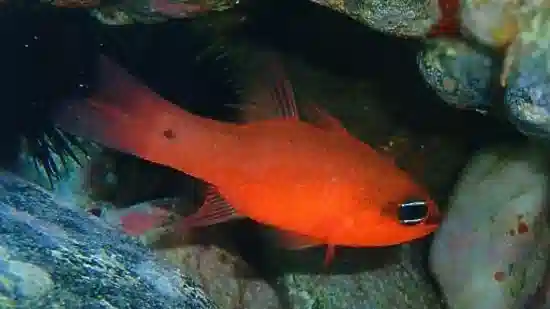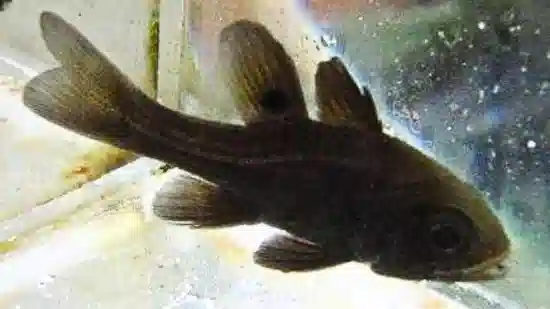Cardinals In Saltwater Aquariums: FAQ
Cardinalfish are small, peaceful reef fish that adapt well to aquariums, but the minimum tank size depends on the species and whether you plan to keep them singly, in pairs, or in groups. Their modest size and calm nature make them popular with both beginners and advanced reef keepers.
General tank size guidelines for cardinalfish:
Smallest species (20 gallons minimum): Pajama Cardinalfish (Sphaeramia nematoptera) and Banggai Cardinalfish (Pterapogon kauderni) can be housed in aquariums as small as 20 gallons if kept singly or as a bonded pair.
Groups (30–40 gallons minimum): If you want to keep a small shoal of 4–6 cardinals, a larger tank is needed to reduce territorial disputes and provide swimming space.
Larger or mixed reef systems (50+ gallons): Ideal for housing multiple cardinals alongside tangs, wrasses, and other active reef fish, since extra space helps diffuse aggression.
Why tank size matters:
Cardinalfish are relatively sedentary compared to tangs or wrasses, but they need open water for schooling behavior and rockwork for nighttime shelter.
Overcrowding in small tanks may lead to stress or fighting, especially among Banggai Cardinals, which can become territorial as they mature.
Stable water quality is easier to maintain in larger aquariums, giving cardinalfish a longer, healthier lifespan.
One Saltwaterfish.com reviewer of the Pajama Cardinal shared: “I purchased 4 of these fish and they are wonderful to watch. All of mine will come to the front of the take as soon as they see me. Very peaceful to tankmates.”.
Pro tips for cardinalfish tank sizing:
Keep single fish or bonded pairs in smaller setups, but upgrade if you want a group.
Provide shaded rockwork or branching coral structures for hiding spots.
- Avoid housing them with overly aggressive tankmates in small systems.
Bottom line: Cardinalfish can live in tanks as small as 20 gallons for a single fish or bonded pair, but groups thrive best in 30–40+ gallon aquariums with open swimming space and rockwork for shelter. Larger reef tanks give them the best chance to display natural schooling behavior, backed by Saltwaterfish.com’s 8-Day Live Guarantee.
Cardinalfish are peaceful, hardy reef dwellers with relatively simple dietary needs. In the wild, they feed primarily on plankton, small crustaceans, and tiny invertebrates at dusk and dawn. In a home aquarium, they adapt well to a variety of prepared foods, making them excellent choices for both beginner and advanced aquarists.
Diet for cardinalfish in aquariums:
Frozen foods: Mysis shrimp, enriched brine shrimp, and finely chopped seafood are excellent staples.
Prepared foods: High-quality marine pellets and flakes, especially those with added spirulina or omega-3s, provide balanced nutrition.
Live foods (optional): Copepods or live brine shrimp can help encourage picky eaters, especially new arrivals.
Variety is key: A mix of meaty and prepared foods ensures strong coloration, healthy growth, and immune support.
Feeding frequency:
Feed small amounts 2–3 times daily. Cardinalfish have small stomachs and prefer multiple feedings over one large meal.
Target feeding with a turkey baster or pipette can help ensure all individuals in a group get their share, especially in busy community tanks.
Scientific studies confirm that cardinalfish are crepuscular planktivores. Marnane and Bellwood (2002) found that wild cardinalfish consume mostly copepods and other planktonic crustaceans.
One Saltwaterfish.com reviewer of the Threadfin Cardinal shared: “Beautiful Threadfin Cardinal swims in out of the rock formation in the saltwater fish tank. Healthy and energetic after acclimation.”.
Pro tips for success:
Feed just before or after lights dim. Cardinals are crepuscular feeders and may eat more actively at these times.
In groups, spread food across the tank to prevent competition.
- Supplement with vitamin-enriched frozen foods to enhance coloration and health.
Bottom line: Cardinalfish thrive on a varied diet of mysis, brine, marine pellets, and occasional live foods, fed 2–3 times daily. With consistent feeding and stable conditions, they adapt quickly and display natural schooling behavior, backed by Saltwaterfish.com’s 8-Day Live Guarantee.
Yes, cardinalfish are 100% reef safe, which makes them one of the most popular community fish for reef aquariums. Unlike some saltwater species that may nip at corals or invertebrates, cardinalfish are peaceful, non-destructive, and thrive in mixed reef systems. Their small size, calm temperament, and simple diet make them excellent additions for both beginners and advanced aquarists.
Why cardinalfish are reef safe:
Coral-friendly: Cardinalfish do not graze, nip, or otherwise damage corals. They prefer to hover in open water or near branching rockwork.
Invert-safe: They coexist peacefully with shrimp, snails, hermit crabs, and other members of your clean-up crew.
Peaceful tankmates: Cardinals rarely show aggression outside of mild squabbles within their own groups, making them excellent companions for clownfish, gobies, tangs, and wrasses.
Interesting cardinals for reef tanks:
*Yellow Cardinalfish (Ostorhinchus luteus) – A peaceful schooling species with a subtle yellow body that contrasts nicely in reef tanks.
*Red Spot Cardinalfish (Apogon parvulus) – A small, striking fish with a bright red body and translucent fins, often kept in groups in larger aquariums.
*Threadfin Cardinalfish (Zoramia leptacantha var.) – Similar to Longspine, but with extended fin filaments; thrives in groups.
One Saltwaterfish.com reviewer of the Orange Stripe Cardinal shared: “A gorgeous healthy Orange Stripe Cardinal. Arrived quickly and adapted quickly. Likes to hang out with my Mimic Tang. I purchased three different species and everyone is doing well\!”.
Pro tips for keeping cardinalfish in reefs:
Provide shaded rockwork or branching structures where they can hover during the day.
Keep them in small groups for natural schooling behavior (space permitting).
Feed small, frequent meals of frozen or pellet foods to mimic their natural plankton-based diet.
Bottom line: Cardinalfish are peaceful, coral-friendly, and 100% reef safe, making them ideal for community reef tanks. With their striking patterns and calm behavior, they add beauty and balance without risk to corals or inverts, backed by Saltwaterfish.com’s 8-Day Live Guarantee.
Cardinalfish are hardy, adaptable, and reef safe, but like all marine fish, they thrive when kept in stable conditions that mimic their natural habitat. Providing the right lighting and water parameters not only supports their health but also helps them show natural behavior such as schooling and hovering calmly in the water column.
Lighting for cardinalfish:
Cardinalfish are crepuscular feeders (most active at dawn and dusk), so they prefer moderate lighting rather than intense reef lights.
In brightly lit SPS tanks, they do best when given shaded areas under rock ledges, caves, or branching corals.
Use sunrise/sunset light settings if possible, gradual transitions reduce stress and encourage more natural feeding activity.
Ideal water parameters for cardinalfish:
Temperature: 74–78°F (23–26°C)
Specific Gravity (Salinity): 1.023–1.026
pH: 8.1–8.4
Alkalinity: 8–12 dKH
Nitrate: \<20 ppm (preferably under 10 ppm for long-term health)
Ammonia & Nitrite: 0 ppm (toxic even at trace levels)
These ranges match the natural reef habitats of Pajama, Banggai, and Longspine Cardinalfish, where waters are warm, stable, and nutrient-poor.
Marnane and Bellwood (2002) found that cardinalfish are most active during crepuscular hours, seeking shelter in shaded coral structures by day.
One Saltwaterfish.com reviewer of the Banggai Cardinal shared: “It's an active fish and it's getting along well with my clowns. Not hiding and it's fun to view the tank with the Cardinal in there.”.
Pro tips for success:
Use LED lighting with adjustable intensity and ramping for natural day/night cycles.
Provide shaded zones where cardinals can hover comfortably.
Keep water parameters stable with regular testing and water changes, cardinals tolerate minor fluctuations but thrive with consistency.
- In groups, larger tanks with stable chemistry reduce territorial stress.
Bottom line: Cardinalfish thrive under moderate lighting with shaded areas and stable reef water parameters (74–78°F, pH 8.1–8.4, salinity 1.023–1.026, nitrates \<20 ppm). By replicating these natural conditions, you’ll keep your cardinals healthy, peaceful, and long-lived, backed by Saltwaterfish.com’s 8-Day Live Guarantee.
Cardinalfish are hardy and beginner-friendly, but like all saltwater fish, they can be sensitive to sudden changes in water conditions. Proper acclimation ensures a smooth transition into your aquarium, reduces stress, and sets them up for long-term health.
Step-by-step acclimation process for cardinalfish:
Float the sealed bag – Place the bag in your aquarium for 15–20 minutes to equalize temperature.
Transfer to a clean container – Gently pour the fish and shipping water into a separate bucket or specimen container.
Drip acclimation – Use airline tubing to slowly drip tank water into the container (2–4 drops per second). Acclimate for 45–60 minutes, doubling the water volume.
Net and transfer – Move the cardinalfish into your display or quarantine tank with a net. Never add shipping water to your aquarium.
Lights off – Keep tank lights dimmed or off for several hours to minimize stress and aggression from established fish.
Special considerations for cardinalfish:
Groups vs. pairs: Pajama and Longspine Cardinals acclimate best in small shoals, while Banggai Cardinals are better introduced as singles or bonded pairs.
Feeding: Offer frozen mysis or brine shrimp within the first 24 hours, most cardinalfish adapt quickly to prepared foods.
Peaceful environment: Cardinalfish are calm by nature. Avoid adding them with aggressive tankmates during acclimation.
Use an acclimation box: In community reefs, these boxes allow the fish to adjust while being visible to existing tankmates, reducing aggression.
One Saltwaterfish.com reviewer of the Flame Cardinal shared: “Good price, fast shipment of my Flame Cardinal.”*.
Bottom line: To acclimate cardinalfish successfully, use the drip method for 45–60 minutes, dim the lights, and provide a calm introduction. Whether adding a shoal of Pajama Cardinals or a pair of Banggais, proper acclimation ensures they thrive in your reef, backed by Saltwaterfish.com’s 8-Day Live Guarantee.
Cardinalfish are hardy, reef-safe fish with relatively long lifespans for their size. In a home aquarium, most cardinalfish live 3–5 years, though some species can reach up to 6–7 years under excellent care. Their longevity depends on stable water quality, proper diet, and stress-free tankmates.
Average lifespans of popular species:
Banggai Cardinalfish (Pterapogon kauderni) – 3–5 years; aquacultured specimens are especially hardy and adapt well to aquarium life.
*Pajama Cardinalfish (Sphaeramia nematoptera) – 4–5 years; peaceful and easy to keep in small groups.
*Longspine Cardinalfish (Zoramia leptacantha) – 3–4 years; thrives in schools when kept in larger reef tanks.
*Orange Lined Cardinalfish (Apogon cyanosoma) – 4–5 years; active, colorful, and well-suited for peaceful communities.
What influences their lifespan:
Water quality: Cardinals tolerate a range of conditions but live longest when parameters are stable (pH 8.1–8.4, temp 74–78°F, nitrates \<20 ppm).
Diet: A varied diet of frozen mysis, brine, and high-quality pellets supports immune health and coloration.
Tank size & setup: Groups of Pajama and Longspine Cardinals need at least 30–40 gallons to prevent crowding stress. Banggai Cardinals do best singly or in bonded pairs.
Stress & aggression: Peaceful tankmates ensure cardinals aren’t bullied, which can shorten lifespan.
One Saltwaterfish.com reviewer of the Pajama Cardinal shared: “Wow, these guys are awesome and fun to watch...very peaceful\!\!\! Larger than I expected, very pleased\!”.
Pro tips for maximizing lifespan:
Feed small meals 2–3 times daily to mimic their natural plankton-feeding habits.
Keep groups of the right size, shoaling species thrive in groups, while Banggais do best as pairs.
Perform regular water changes to keep nitrates low and oxygen levels stable.
Bottom line: Cardinalfish typically live 3–5 years in home aquariums, with some reaching 6–7 years under optimal conditions. With stable water, a varied diet, and peaceful tankmates, they’ll reward you with years of calm, graceful schooling behavior, backed by Saltwaterfish.com’s 8-Day Live Guarantee.
The best place to buy healthy cardinalfish online is Saltwaterfish.com. With decades of experience supplying marine livestock, Saltwaterfish.com is a trusted source for both beginner-friendly and rare species, backed by excellent customer reviews and the industry-leading 8-Day Live Guarantee.
Why choose Saltwaterfish.com for cardinalfish:
Wide selection: From classic species like the Banggai Cardinalfish (Pterapogon kauderni) and Pajama Cardinalfish (Sphaeramia nematoptera) to more unique varieties such as the Orange Lined Cardinal (Apogon cyanosoma), Saltwaterfish.com offers one of the most diverse collections available online.
Healthy livestock: Every fish is carefully handled, acclimated, and shipped with professional care. Customers frequently highlight how quickly their fish begin eating and acting naturally after arrival.
Customer-rated excellence: One Saltwaterfish.com reviewer of the Banggai Cardinal shared: “It's an active fish and it's getting along well with my clowns. Not hiding and it's fun to view the tank with the Cardinal in there.”.
Aquacultured availability: Many cardinalfish, including Banggai Cardinals, are available as aquacultured options, healthier for your tank and more sustainable for wild populations.
- 8-Day Live Guarantee: Every order is covered, giving you confidence that your cardinalfish will arrive in top condition.
Bottom line: For healthy, reef-safe cardinalfish delivered straight to your door, Saltwaterfish.com is the best online store. With a broad selection, aquacultured availability, strong customer reviews, and the 8-Day Live Guarantee, you can shop confidently and enjoy vibrant, hardy cardinalfish in your reef.
Cardinalfish are peaceful, hardy, and reef safe, making them some of the best community fish for saltwater aquariums. They adapt well to captive life, accept a wide variety of foods, and provide calm, mid-water movement that balances the activity of more energetic species like wrasses and tangs. The best cardinalfish combine beauty, adaptability, and compatibility with reef setups.
Top cardinalfish for saltwater aquariums:
Banggai Cardinalfish (Pterapogon kauderni) – With their striking black-and-silver stripes and elegant long fins, Banggais are among the most popular. They thrive as singles or bonded pairs in tanks 20+ gallons and are widely available as aquacultured, making them sustainable and hardy.
*Pajama Cardinalfish (Sphaeramia nematoptera) – Recognizable by their spotted “pajama” pattern and red eyes, Pajama Cardinals are peaceful, beginner-friendly, and thrive in groups. They adapt well to both nano reefs and large community systems.
*Longspine Cardinalfish (Zoramia leptacantha) – Known for their translucent blue shimmer, Longspine Cardinals display stunning schooling behavior when kept in groups of 6 or more, making them ideal for larger reef aquariums.
*Orange Lined Cardinalfish (Apogon cyanosoma) – A smaller, schooling species with bright orange stripes, perfect for peaceful community setups.
Why these species stand out:
All are reef safe, causing no harm to corals or invertebrates.
They accept frozen, live, and pellet foods with ease.
Their calm swimming contrasts beautifully with more active reef fish, adding balance and variety to displays.
One Saltwaterfish.com reviewer of the Pajama Cardinal shared: “These are super cute...like big dolls that just gently float around, super healthy, awesome price”.
Pro tips for choosing cardinalfish:
Keep singles or pairs of Banggais, as groups may fight once they mature.
Pajamas and Longspines do best in small shoals to display natural behavior.
- Provide shaded rockwork or branching structures, since cardinals are crepuscular (dusk/dawn active).
Bottom line: The best cardinalfish for saltwater aquariums are the Banggai, Pajama, Longspine, and Orange Lined Cardinals. Hardy, peaceful, and reef safe, they add elegance and calm schooling motion to any tank, backed by Saltwaterfish.com’s 8-Day Live Guarantee.
Yes, aquacultured cardinalfish are generally better than wild-caught for most home aquariums. They are hardier, more sustainable, and often easier to care for, which is why many aquarists prefer them when available. Species like the Banggai Cardinalfish (Pterapogon kauderni) are now widely aquacultured and make excellent choices for reef tanks.
Benefits of aquacultured cardinalfish:
Hardier and disease-resistant: Aquacultured cardinals are raised in captive systems, making them better adapted to aquarium life. They typically handle shipping stress, acclimation, and captive diets better than wild fish.
Readily accept prepared foods: Most aquacultured cardinals will eat frozen mysis, brine shrimp, and pellets right away, reducing the risk of starvation.
Sustainable choice: Aquaculture reduces pressure on wild populations. This is especially important for Banggai Cardinalfish, which are listed as endangered in the wild by the IUCN due to overcollection.
Less environmental impact: Supporting aquacultured livestock helps preserve natural reefs and promotes responsible aquarium practices.
When wild-caught may still appear:
Some rarer cardinal species (like Longspine Cardinals) are not yet widely available in aquaculture and may still be wild-caught. In these cases, buying from a trusted source like Saltwaterfish.com ensures ethical handling and an 8-Day Live Guarantee for peace of mind.
Scientific research strongly supports the advantages of aquacultured cardinalfish. Vagelli (2011) showed that captive-bred Pterapogon kauderni exhibit higher survival and faster acclimation to aquarium diets compared to wild-caught individuals. Furthermore, Wabnitz et al. (2003) emphasized that aquaculture plays a critical role in protecting wild Banggai populations, which have declined sharply due to overcollection. Choosing aquacultured stock not only enhances fish welfare and longevity but also contributes directly to reef conservation and sustainable aquarium practices.
One Saltwaterfish.com reviewer of the Pajama Cardinal shared: “I purchased two of these fish recently, and they are so spunky. They have great personalities and stick together. They are very happy and healthy in my 180gal.”*.
Bottom line: Aquacultured cardinalfish are hardier, easier to feed, and environmentally responsible, making them the better option whenever available. Wild-caught cardinals can still thrive if sourced responsibly, but aquacultured fish give you the highest success rate and peace of mind, backed by Saltwaterfish.com’s 8-Day Live Guarantee.
Yes many cardinalfish species display schooling or shoaling behavior, especially in larger reef aquariums. In the wild, species like the Pajama Cardinalfish (Sphaeramia nematoptera) and Longspine Cardinalfish (Zoramia leptacantha) form tight groups for protection and social interaction. In home aquariums, they often hover together in open water or near branching rockwork, creating a calm and visually striking effect.
Schooling behavior in aquariums:
Pajama Cardinalfish – Readily shoal in groups of 4–6, hovering in mid-water with their unique spotted pattern.
Longspine Cardinalfish – One of the most schooling-oriented species; best displayed in larger groups (6–10+) under moderate lighting.
Banggai Cardinalfish (Pterapogon kauderni) – Unlike other cardinals, Banggais can become territorial as they mature. While juveniles shoal, adults are better kept as singles or bonded pairs.
Why tank size matters:
In small aquariums, aggression can increase, especially with Banggai Cardinals. A 30–40 gallon tank minimum is recommended for small groups.
Larger tanks (50+ gallons) allow for more natural schooling behavior and reduce territorial disputes.
Provide shaded rockwork or branching corals for resting areas, since cardinals are crepuscular (most active at dawn and dusk).
One Saltwaterfish.com reviewer of the Banggai Cardinal shared: “This guy is just a sweetie like to hang out by a favorite coral or area and grace around. calm & would fit anywhere w/o bully fish”.
Pro tips for keeping schooling cardinals:
Keep at least 3–5 individuals (more if space allows) to encourage natural shoaling.
Introduce them simultaneously to avoid hierarchy issues.
- Avoid housing Banggai Cardinals in large groups unless you can separate pairs as they mature.
Bottom line: Cardinalfish such as Pajama and Longspine Cardinals readily school in home aquariums when kept in groups, while Banggai Cardinals are best as singles or pairs once mature. In the right tank, a group of cardinals creates a peaceful, eye-catching mid-water display, backed by Saltwaterfish.com’s 8-Day Live Guarantee.
























